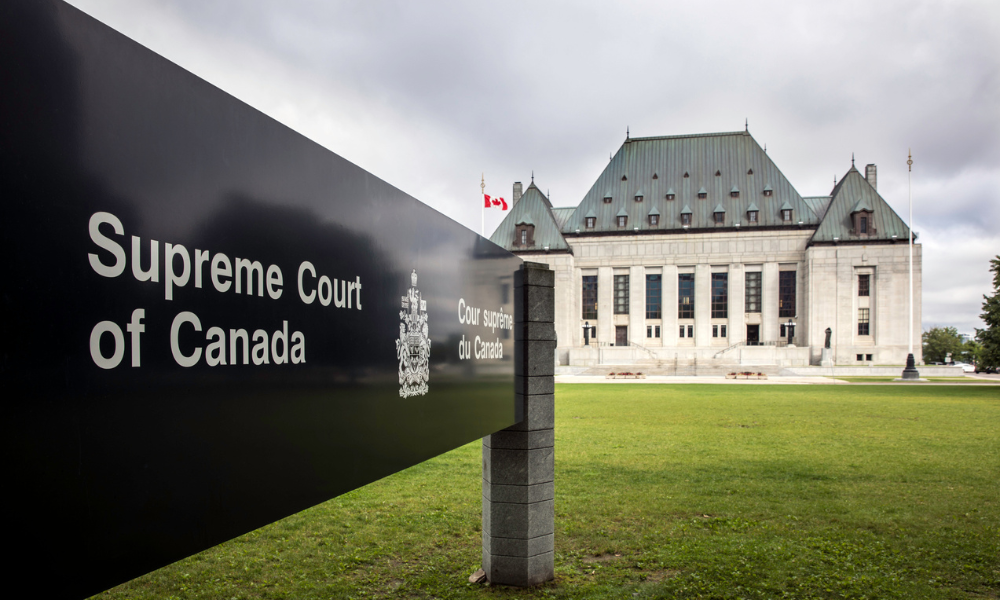
Legislation went beyond division of powers framework, top court says

A split bench offered up a divided opinion at the Supreme Court of Canada in a case that questioned the constitutionality of the Impact Assessment Act (IAA) and held broader implications regarding the scope and reach of federal legislation, especially regarding protecting the environment.
The Attorney General of Canada v. Attorney General of Alberta, SCC 40195 was appealed to the court after a non-binding majority decision from the Alberta Court of Appeal concluded that the IAA and the Physical Activities Regulations (which were made under the IAA by the Governor in Council) were ultra vires Parliament and therefore unconstitutional in their entirety.
The justices of the Supreme Court of Canada – excepting Justice Andromache Karakatsanis and Justice Mahmud Jamal, who dissented in part – decided that the appeal should be allowed in part.
The reference opinion written by Chief Justice Wagner acknowledges that “Environmental protection remains one of today’s most pressing challenges, and Parliament has the power to enact a scheme of environmental assessment to meet this challenge, but Parliament also has the duty to act within the enduring division of powers framework laid out in the Constitution.”
It further says that “the presumption of constitutionality is a cardinal principle of the Court’s division of powers jurisprudence. According to this presumption, every legislative provision is presumed to be intra vires the level of government that enacted it so a court should approach any question as to its validity on the assumption that it was validly enacted unless the party challenging it demonstrates otherwise… However, this presumption is not an impermeable shield that protects legislation from constitutional review by courts…”
As the SCC explained, “The assessment process set forth in ss. 81 to 91 [of the IAA] focuses on a narrow set of projects: physical activities carried out on federal lands or outside Canada in relation to a physical work that are not designated projects or physical activities designated by regulation, and physical activities designated under s. 87 or that are part of a designated class of physical activities. Sections 81 to 91 do not dictate an impact assessment process but rather require the federal authority that carries out or finances the project to decide if the project is likely to cause significant adverse environmental effects. If so, it must then be determined whether these effects are justified in the circumstances.”
The top court specifically addressed these sections – ss. 81 to 91 – and the designated projects.
In the court’s view, “The reference questions should be answered in the affirmative: the federal impact assessment scheme is unconstitutional in part. Although the process set forth in ss. 81–91 of the IAA is constitutional and can be separated out, the balance of the scheme – that is, the “designated projects” portion – is ultra vires Parliament and thus unconstitutional. The designated projects scheme is ultra vires for two overarching reasons: it is not in pith and substance directed at regulating ‘effects within federal jurisdiction’ as defined in the IAA because these effects do not drive the scheme’s decision-making functions, and the defined term ‘effects within federal jurisdiction’ does not align with federal legislative jurisdiction. The overbreadth of these effects exacerbates the constitutional frailties of the scheme’s decision-making functions.”
The SCC also addressed the “double doctrine” nature of Canada’s constitutionally derived division of powers. “[T]he fact that environmental assessment of physical activities may have a double aspect – with some elements falling within the legislative authority of each level of government – does not mean that it is an area of concurrent jurisdiction. If a fact situation can be regulated from both a federal perspective and a provincial perspective, it follows that each level of government can only enact laws which, in pith and substance, fall under its respective jurisdiction.”

Andrew Bernstein
According to Andrew Bernstein, a partner at Torys LLP, the court’s approach was expected.
“I'm not surprised. I think there was a feeling among many constitutional lawyers that the federal government had gone a little too far in terms of regulating things that are predominantly provincial,” he says.
“I think almost certainly we’ll see a rewrite of the Impact Assessment Act. The federal government needs environmental legislation, like the Impact Assessment Act, for a whole variety of reasons. The court absolutely affirmed that there is a federal role to play, even if a project is predominantly within provincial jurisdiction. It just said that the role is a lot narrower than the Act, as currently constituted, would provide.”
Revising the act certainly seems to be the federal government’s intention. In a press conference, the Minister of Energy and Natural Resources Jonathan Wilkinson told reporters, “The court found that the Impact Assessment Act is constitutional in part, but that in some instances, the language in the ACT needs to be more closely tethered to areas of federal jurisdiction. We, of course, accept the direction provided by the court, and we will be bringing forward the necessary amendments.”
Bernstein says the areas of federal jurisdiction are relatively well-defined, and he doesn’t expect much debate over those.
“It’s an imperfect idea, but we have a pretty good idea of what is and isn’t federal. Fisheries and Indigenous people are the examples that the court uses over and over again. Other things might pop up depending on what’s at issue and where the project is. The general idea that the court laid out is you have to stick to areas of federal jurisdiction. You can collect information about anything that you want. But when you’re making a decision, you have to decide based on areas of federal jurisdiction – you can’t just say, ‘this might have an impact on fisheries, so we’re going to decide whether it’s in the public interest.’”
Lynne Watt is head of the Supreme Court of Canada services group at Gowling WLG International Limited. She is also the agent of counsel for several parties in this case, including the Attorney General of Alberta, the attorneys general of Manitoba, Saskatchewan, New Brunswick, Newfoundland, and Labrador and the intervener Woodland Cree First Nation. She says this opinion indicates how modern priorities weren’t considered when the country was founded in 1867.
“The ongoing challenge that this court and all courts have in dealing with environmental issues and the legislation trying to address them is something that’s going to be with us for a long time, arising, obviously, out of the way the Constitution was drafted and the fact that environmental issues don’t fall directly under one head of power or the other. We’re grappling with a document that was written a long time ago when environmental issues and governmental legislation in respect of the environment was not anticipated.”
Despite that challenge, she says the SCC clearly outlined how governments must proceed when evaluating environmental projects or drafting the legislation that allows them to do so.
“The majority opinion has a very clear articulation of the interpretive steps that must be followed when looking at or trying to characterize and classify a piece of legislation. The majority opinion goes into quite a rigorous analysis about how that is to be done at large. So that’s going to help advance interpretation of the constitutionality of legislation. The application of those tests is always the challenge, and I think this case exemplifies what we see in many cases… how does one define the essence of the legislation in question? How is it characterized? (As that must be done first). And once that characterization is done, then it’s classified through the heads-of-power analysis.”
Nature Canada and West Coast Environmental Law (WCEL) were both interveners in this case. While the judgement wasn’t entirely what they were hoping for, both organizations were able to find positives in the SCC’s opinion.
“This is not the win that Alberta was hoping for. The entire court – majority and minority opinions – agreed with our arguments about when the federal government can require an assessment and the information that can be considered. Overall, we think this opinion can be a win for Canadians and the environment, but Parliament needs to step up and enact amended assessment legislation that applies to all projects with the potential to harm areas of federal jurisdiction,” said Anna Johnston, a WCEL staff lawyer who appeared for both interveners.
“Nature Canada’s view is that the constitutional issues identified by the court can be addressed by a handful of amendments to the Impact Assessment Act. The challenge for the federal government is to work with the provinces, Indigenous nations and consult with the public to ensure that the revised law aligns with the court’s decision. In sum, the court has confirmed the federal government’s critical role in ensuring a safe and healthy environment for Canadians. This is a far cry from the position of the government of Alberta,” said Stephen Hazell, emeritus counsel, Nature Canada, in that same statement.
In considering what effects this opinion will have on the legal landscape in Canada, Watt doesn’t expect conflicts about environmental jurisdiction to end anytime soon.
“I think it may depend on which government is in power at any one time, but any government that passes what some people might characterize as a pro-environmental type of legislation may be challenged about whether they have the jurisdiction to do so,” she says.
“All of the decisions in this case, from the Alberta Court of Appeal, and the majority and minority decisions at the Supreme Court of Canada, all recognize the challenge that governments are facing, and the importance of coming to terms with environmental concerns – that governments can’t just stand back and not act. The court is alive to that. They’re not being dismissive in any way of the federal government’s bona fides in passing legislation, but they’re just trying to set the right boundaries.”